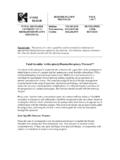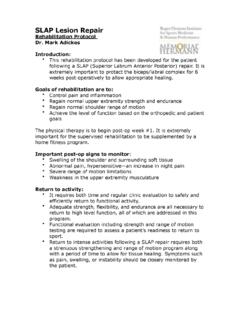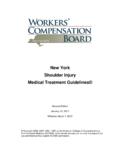Transcription of Rehabilitation of the thrower’s elbow
1 Clin Sports Med 23 (2004) 765 801. Rehabilitation of the thrower 's elbow Kevin E. Wilk, PT a,b,*, Michael M. Reinold, DPT, ATC, CSCSa, James R. Andrews, MDa,b,c a HealthSouth Corporation, American Sports Medicine Institute, 1201 11th Avenue South, Suite 100, Birmingham, AL 35205, USA. b Tampa Bay Devil Rays Baseball Organization, One Tropicana Drive, Tampa Bay, FL 33705, USA. c Alabama Orthopedic and Sports Medicine Center, 1201 11th Avenue South, Suite 200, Birmingham, AL 35205, USA. Injuries to the elbow occur often in the overhead athlete. The repetitive overhead motion involved in throwing is responsible for unique and sport- specific patterns of elbow injuries.
2 These are caused by chronic stress overload or repetitive microtraumatic stress observed during the overhead pitching motion as the elbow extends at over 23008/s, producing a medial shear force of 300 N and compressive force of 900 N [1,2]. In addition, the valgus stress applied to the elbow during the acceleration phase of throwing is 64 Nm [1,2], which exceeds the ultimate tensile strength of the ulnar collateral ligament (UCL) [3]. Thus, the medial aspect of the elbow undergoes tremendous tension (distraction) forces, and the lateral aspect is forcefully compressed during the throw. The overhead athlete is susceptible to specific elbow injuries.
3 A number of forces act on the elbow during the act of throwing [1,2], including valgus stress with tension across the medial aspect of the elbow . These forces are maximal during the acceleration phase of throwing. Compression forces are also applied to the lateral aspect of the elbow during the throwing motion. The posterior compartment is subject to tensile, compressive, and torsional forces during ac- celeration and deceleration phases. This may result in valgus extension overload within the posterior compartment, potentially leading to osteophyte formation, stress fractures of the olecranon, or physeal injury [4,5].
4 * Corresponding author. HealthSouth Corporation, American Sports Medicine Institute, 1201 11th Avenue South, Suite 100, Birmingham, AL 35205. E-mail address: ( Wilk). 0278-5919/04/$ see front matter D 2004 Elsevier Inc. All rights reserved. 766 Wilk et al / Clin Sports Med 23 (2004) 765 801. This article provides an overview of general Rehabilitation principles for the thrower 's elbow . Specific nonoperative and postoperative treatment guidelines for the thrower 's elbow are also discussed. General Rehabilitation guidelines Rehabilitation following elbow injury or elbow surgery follows a sequential and progressive multiphased approach.
5 The ultimate goal of elbow Rehabilitation is to return the athlete to the previous functional level as quickly and safely as possible. This section provides an overview of the Rehabilitation process following elbow injury, outlined in Box 1, and surgery, outlined in Box 2. Re- habilitation protocols for specific pathologies will follow. Phase I immediate motion phase The first phase of elbow Rehabilitation is the immediate motion phase. The goals of this phase are to minimize the effects of immobilization, to reestablish non- painful ROM, to decrease pain and inflammation, and to retard muscular atrophy.
6 Early range-of-motion activities are performed to nourish the articular cartilage and assist in the synthesis, alignment, and organization of collagen tissue [6 14]. ROM activities are performed for all planes of elbow and wrist motions to prevent the formation of scar tissue and adhesions. Active-assisted and passive ROM exercises are performed for the humeroulnar and joint to restore flexion/extension and supination/pronation for the humeroradial and radialulnar joints. Reestablishing full elbow extension, or preinjury motion, is the primary goal of early ROM activities, in order to minimize the occurrence of elbow flexion contractures [15 17].
7 The preoperative elbow motion must be carefully assessed and recorded. The athlete should be asked whether or not full elbow extension has occurred in the past 2 to 3 years. Postoperative ROM is often related to preoperative motion, especially in the case of UCL reconstruction. This can be a deleterious side effect for the overhead athlete. The elbow is predisposed to flexion contractures, due to the intimate congruency of the joint articulations, the tightness of the joint capsule, and the tendency of the anterior capsule to develop adhesions following injury [14]. The brachialis muscle also attaches to the capsule and crosses the elbow joint before becoming a tendinous structure.
8 Injury to the elbow may cause excessive scar tissue formation of the brachialis muscle and functional splinting of the elbow [14]. In addition to ROM exercises, joint mobilizations may be performed as tolerated to minimize the occurrence of joint contractures. Posterior glides with oscillations are performed at end range of motion to assist in regaining full elbow extension. Initially Grade I and II mobilizations are used, progressing to aggressive mobilization techniques at end range of motion during later stages of Rehabilitation , when symptoms have subsided. Joint mobilization must include the radiocapitallor and radioulnar joints.
9 Wilk et al / Clin Sports Med 23 (2004) 765 801 767. Box 1. Nonoperative Rehabilitation program for elbow injuries Acute phase (week 1). Goals: improve motion, diminish pain and inflammation, retard muscle atrophy Exercises 1. Stretching for wrist and elbow joint; stretches for shoulder joint 2. Strengthening exercises: isometrics for wrist, elbow , and shoulder musculature 3. Pain and inflammation control cryotherapy, high voltage gal- vanic stimulation (HVGS), ultrasound, and whirlpool Subacute phase (weeks 2 4). Goals: normalize motion; improve muscular strength, power, and endurance Week 2.
10 1. Initiate isotonic strengthening for wrist and elbow muscles. 2. Initiate exercise tubing exercises for shoulder. 3. Continue use of cryotherapy, etc. Week 3. 1. Initiate rhythmic stabilization drills for elbow and shoulder joint. 2. Progress isotonic strengthening for entire upper extremity. 3. Initiate isokinetic strengthening exercises for elbow flexion/. extension. Week 4. 1. Initiate thrower 's ten program. 2. Emphasize eccentric biceps work, concentric triceps work, and wrist flexor work. 3. Program endurance training. 4. Initiate light plyometric drills. 5. Initiate swinging drills.







